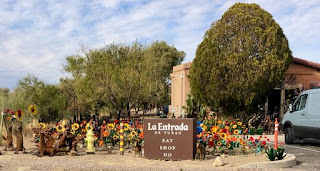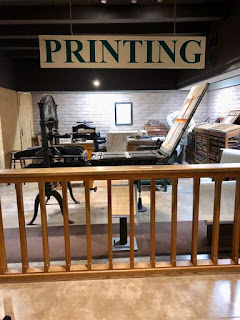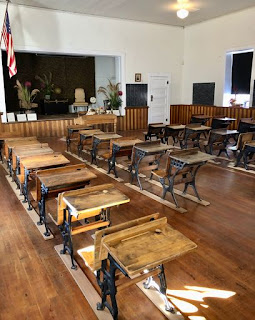What would draw one to a small southern Arizona town with a population just under 1,400 with an average age of 64? That was certainly the question I asked myself but a recent trip to Tubac, Arizona proved to be both historically and culturally stimulating.
Apaches attached Tubac repeatedly in the 1840s, forcing the Sonoran Mexicans to abandon the town. By 1861 Tubac became the scene of a four-day siege between Tubac's male population, Confederate militia and Apache warriors. The Confederates would win but when Union troops started to approach Tucson, just to the north, the Confederate troops would abandon Tubac.
In the 1930s–1960s Tubac became an art colony. Painter Dale Nichols opened an art school in 1948 and restored some of Tubac's historic buildings. Students included water colorist Al Romo and sculptor Bob Brisley. Other artists included Sophie and Harwood Steiger, Hal Empie and Hugh Cabot.
My drive from Green Valley, Arizona to Tubac took about 20 minutes. First I simply drove up and down the streets, taking in all the colorful sights. What I immediately noticed was how ‘artsy’ the place was. I would later learn that this small little town was host to Southern Arizona’s longest running arts festival. The Tubac Arts Festival spans a 62-year tradition that draws tens of thousands of visitors each year.
My first real stop would be the Tubac Presidio State Historic Park
With over 2,000 years of history, it represents the first Arizona state park and is the historic site of the oldest fort and European village in Arizona. My visit included an orientation video followed by a walk through the gift shop and bookstore. Then it was outside to walk the grounds, take the steps down to the underground exhibit of the Presidio ruins and experience the Griffin Museum. I also took a step back in time as I stepped inside the 2nd oldest schoolhouse in Arizona. Lastly it was a tour through Otero Hall. Time seemed to fly by as I found myself spending 1.5 hours here. I could easily have spent another hour but had to move on due to a scheduled appointment. Be sure to allow plenty of time to explore this treasure in Tubac.
The Visitor Center is located in the historic teachers' quarters for the 1885 Old Schoolhouse. As I exited the orientation video I noticed an interesting blackboard titled Tubac Firsts.
The Griffin Museum is named in honor of the donors who helped create the Presidio in 1959 and who also donated the land to build the museum. I found one of the most memorable items to be an original Washington Printing Press. In 1858 John and William Wrightson, of the Santa Rita Mining and Exploring Company, purchased the Washington Press in Cincinnati, Ohio, and had it shipped down the Ohio River to New Orleans. The press was then shipped on a packet boat to Indianola, Texas, and then brought overland to Tubac by mule train.
On March 3, 1859 in Tubac editor, Edward E. Cross, issued Volume I, number 1 of The Weekly Arizonian, the first newspaper printed in what is now Arizona. It was then part of the New Mexico Territory. It consisted of four pages of news and advertising. The Park still prints this exact newsletter on the Washington Press and sells them in the gift shop.
Otero Hall was named after the Otero Family, who received the first Spanish land grant in 1797. Originally build as a community center in 1914, the foundation was from a previous building which the Spanish had built in the late 1700s.
Otero Hall is on the National Register of Historic Places and houses a restored 1850s wagon called an “ambulance.” which was used for travel. A leather thoroughbrace suspension allows the body to move freely providing a more comfortable ride. Buffalo Bill had one to go to his shows. An old print showed one modified to carry stretchers, which is probably the origin of the modern use of the word “ambulance.” It is the only vehicle of it's type on public display.
Otero Hall also features a
rotating art exhibition in the Shaw D. Kinsley Gallery. The exhibition on display during my visit was titled "The Cavalcade of History." The collection was made by Western artist William Ahrendt and was donated to the Presidio by
an anonymous donor.
Tubac also claims to be home to the first school based on the fact that Otero Hall served as a schoolhouse before the 1885 schoolhouse was constructed.
The schoolhouse, on the National Register of Historic Places, is the second oldest schoolhouse in Arizona. With original floors and walls, you can sit at the desks and just imagine learning math or science in this one-room schoolhouse. You can also take an 1895 eight grade final exam to see if you can pass!
One of the things I really enjoyed was the blackboards on both sides of the room. On one side of the room it listed the teacher duties from 1895.
The other side of the room featured blackboards listing student punishment.
Since 2010 the Park has been operated by the Friends of the Tubac Presidio and Museum in a public-private partnership with the state of Arizona and is a 501(c)(3) non-profit. The Park is supported by approximately fifty trained community volunteers and one staff member.
Tubac is now home to over 100 art galleries, home decor boutiques, gift shops, jewelers, potters and artists of every kind. There is a very active Art school, many gourmet restaurants, and a golf resort.
#Tubac #Arizona





















No comments:
Post a Comment